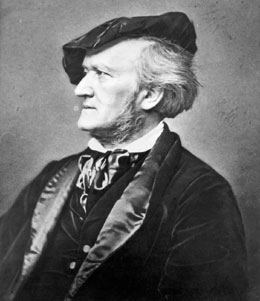Many Italian operas were composed as "number operas" with linking recitative. For example, no 1: Overture, no 2: opening chorus, recitative, no 3: hero's aria, recitative, no 4: hero's cabaletta with chorus. Each number therefore, had a very clear beginning and end. Wagner's operas, however, are much more through-composed: they have less defined beginnings and ends and so are often less excerptable than Italian operas. These excerpts are sometimes known as "bleeding chunks" as they are pulled out of their musical context with a fade or by editing the music. In addition, Wagner's music, with its use of leitmotivs and declamatory style, is often less "tuneful" or "melodic" than some Italian operas. Below are some of the "highlights" from Wagner's operas.
Many of Wagner's works open with an orchestral overture or prelude. Here are the overtures to Rienzi, 1840: http://www.youtube.com/watch?v=CTcE_rDt6Dw
Tannhauser, 1845: http://www.youtube.com/watch?v=9TEVjvFp5Yw
Lohengrin, 1850 (one of the most serene pieces of music): http://www.youtube.com/watch?v=JGIH1_nLG-Y
Tristan und Isolde, 1865: http://www.youtube.com/watch?v=7_7HUTE-SIg
Die Meistersinger von Nurnberg, 1868: http://www.youtube.com/watch?v=AQB3rWeFFFM
Parsifal, 1882 (with some amazing, other-worldly sounds from the orchestra): http://www.youtube.com/watch?v=HjtS_ogRxQU
Following a feisty, celebratory prelude in the third act of Lohengrin comes one of the most famous choruses in the repertoire, the Bridal Chorus, sung to celebrate the newly wed Lohengrin and Elsa: http://www.youtube.com/watch?v=ap17Su6yX9w
Also from Lohengrin, his aria in which he reveals his history, In fernem land, here sung by Placido Domingo: http://www.youtube.com/watch?v=syLhrx1Ogbo and here, in a version by Jonas Kaufmann: http://www.youtube.com/watch?v=65bTYJkpffU
From Tannhauser, the Pilgrim's Chorus uses a theme that is first heard in the overture: http://www.youtube.com/watch?v=mADk_bqsr6M The third act is based around a song contest. Here is the baritone's entry, O du mein holder abendstern, The song to the evening star: http://www.youtube.com/watch?v=PLpLBssY9ko
Die Meistersinger also climaxes in a singing competition, the winner of which will win the hand of the fair Eva. Walter composes and changes his Prize Song throughout the opera. At the end of the opera (and five hours or so after the opera began) he sings his song and claims his bride: http://www.youtube.com/watch?v=NrjnelUsbZI
Tristan und Isolde tells the story of an all powerful and consuming love. Looking at the body of her beloved Tristan, Isolde transports herself into a state of ecstasy and dies singing the Liebestod (Love Death). It contains one of the most famous climaxes in music, a swirling, orgasmic swell of music which fades away exhausted into nothing: http://www.youtube.com/watch?v=tM0SVA3b0XE In concerts, the Liebestod is often added to the Prelude to create a 20 minute piece: http://www.youtube.com/watch?v=kzDXwDbUdtA
The fifteen-hour Ring cycle has quite a few moments which can be excerpted. From Das Rheingold, the final Entry of the gods in Valhalla: http://www.youtube.com/watch?v=GjqDic27Ook in the infamous centenary production from Bayreuth. From Die Walkure, Siegmund welcomes in spring in Wintersturme: http://www.youtube.com/watch?v=eMmZwoLZNQ8 and the opera closes with Wotan's Farewell to his disobedient daughter, encircling her in a ring of fire http://www.youtube.com/watch?v=XcDPZoHD1aI . However, the last act opens with perhaps the most famous of all Wagner tunes, the popular Ride of the Valkyries, the warrior daughters of Wotan: http://www.youtube.com/watch?v=svMHBPed9Bs The third opera, Siegfried, sees the hero forging a broken sword http://www.youtube.com/watch?v=n0H_DokyVhM who goes on to walk through the fire and awaken Brunnhilde from her sleep. Siegfried is killed in the final opera, Gotterdammerung, and a massive funeral march accompanies the carrying of his body: http://www.youtube.com/watch?v=XPmldLR3bJw The cycle ends with Brunnhilde's Immolation, throwing herself onto Siegfried's funeral pyre while the ring of power is washed back into the river Rhine: http://www.youtube.com/watch?v=dpzwvlEVLgM
The entire playlist can be seen here: http://www.youtube.com/playlist?list=PL60A7A562333A2248
Wagner makes huge demands on his singers: they need to be able to sing for long periods of time and last for four or five hours (not always singing, of course), and be able to sing over a large orchestra. These voices are often described as Helden, Heroic as in Heldentenor. Singers particularly associated with Wagner include the sopranos Kirsten Flagstad, Birgit Nilsson, Gwyneth Jones, Hildegard Behrens; tenors Wolfgang Windgassen, Jon Vickers, Lauritz Melchior, Siegfried Jerusalem; bass-baritones Hans Hotter, John Tomlinson, James Morris. (Of course, as everyone knows, the greatest Wagner performance of Walkure and Tannhauser can be found here: http://www.funnyjunk.com/movies/3182/What+s+Opera+Doc/ )

So many lovely links. So very little battery life :( I did have to listen to bits of a few though. I do love knowing the music everyone has heard I'm sure is called "Ride of the Valkyries". I really would like to see Tristan and Isolde.
ReplyDeleteWagner truly does demand much of his singers. I was amazed at how much singing Bryn Terfel had to do and how great he sounded all the way through.
Thanks again.